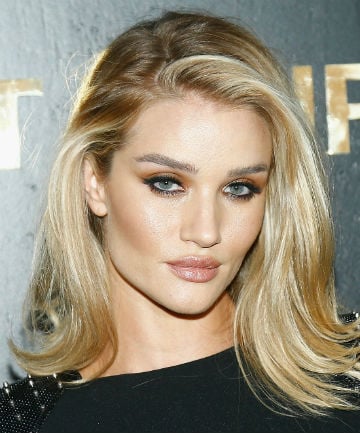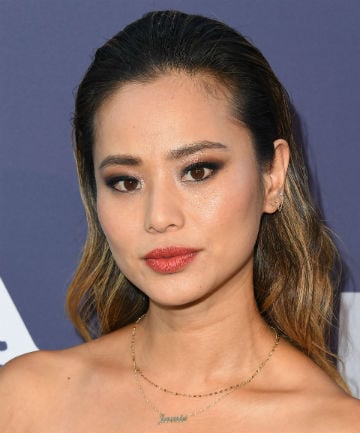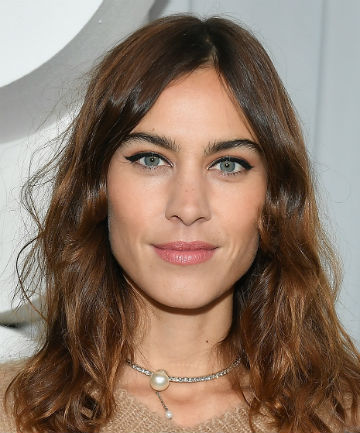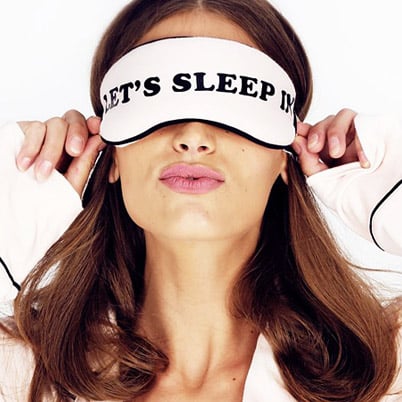Let's start with the basics. Foil highlights are the ones you're probably most familiar with, and the first thing that comes to mind when you think "highlights." There's a reason why the old standby is still an old standby. "Foils are the best way to go all around," says Pelusi. "The easiest way not to damage the hair is to ask for foils because it's generally the safest."
The foils separate hair that is to be highlighted from hair that will remain its natural color, while sealing the developer and lightener in the hair during the processing time. What makes this method trustworthy is its ubiquity. "Most stylists today are somewhat versed in foil placement. I personally love foil placement, because I can get the most control over where I'm placing the highlight color, and the highlights, and this helps to maintain the quality and condition of the hair while highlighting."
Image via Steve Granitz/WireImage/Getty
The foils separate hair that is to be highlighted from hair that will remain its natural color, while sealing the developer and lightener in the hair during the processing time. What makes this method trustworthy is its ubiquity. "Most stylists today are somewhat versed in foil placement. I personally love foil placement, because I can get the most control over where I'm placing the highlight color, and the highlights, and this helps to maintain the quality and condition of the hair while highlighting."
Image via Steve Granitz/WireImage/Getty
Lowlights are, as expected, the opposite of highlights. Instead of lifting the color of the hair a few shades, stylists will use the same foil method to take strategically placed strands a few shades darker than the natural base color to achieve a softer, darker color. "If you feel your hair is looking a bit too solidly one color, then it's time for some lowlighting." This technique is especially good for adding dimension, depth and appearance of thicker hair while creating a more natural-looking blend.
Image via Cindy Ord/Getty
Image via Cindy Ord/Getty
OK, you know what type of highlights you want, now how much? Here is where the terms "full" and "partial" come into play. Partial highlights (like Rosie Huntington-Whiteley's) are usually placed around the face for a brightening or framing effect, while full gets you just that — your full head highlighted. "If your hair — including the back — is dark, you will need a full highlighting. If it hasn't been that long since your last highlighting service, or if your hair, especially the back, isn't that dark, just go with a partial."
Still not sure where you land? "A general recommendation is to do a partial at one visit, and a full on the next. It's a good rule of thumb and easier and better for the pocketbook to alternate."
Image via Julien Hekimian/Getty
Still not sure where you land? "A general recommendation is to do a partial at one visit, and a full on the next. It's a good rule of thumb and easier and better for the pocketbook to alternate."
Image via Julien Hekimian/Getty
We've been hit over the head with ombre hair for quite a few seasons now, and it still seems like there's no end in sight.
"Ombre, in hair color terms, refers to going from dark to light. Sarah Jessica Parker I think was the first one — way, way back — with "Sex and the City" — when she just had some roots. Gradually, though, the trend caught on and got more extreme, with women wearing super dark roots, and super blonde highlighted mid-lengths and ends." To get this look, your stylist will lighten the lower half of your hair using traditional highlighting foils, leaving your natural roots and color intact. If you want less of the two-toned, dip-dyed look, then you're probably better off with ...
Image via Jon Kopaloff/FilmMagic/Getty
"Ombre, in hair color terms, refers to going from dark to light. Sarah Jessica Parker I think was the first one — way, way back — with "Sex and the City" — when she just had some roots. Gradually, though, the trend caught on and got more extreme, with women wearing super dark roots, and super blonde highlighted mid-lengths and ends." To get this look, your stylist will lighten the lower half of your hair using traditional highlighting foils, leaving your natural roots and color intact. If you want less of the two-toned, dip-dyed look, then you're probably better off with ...
Image via Jon Kopaloff/FilmMagic/Getty
You know that perfectly sun-kissed color that has become the signature of Giselle and Jessica Biel, to name a few? Often mistakenly referred to as ombre, the technique at play is ombre's fancy French cousin, Balayage. With no foil in sight, stylists physically paint the color directly onto sections of hair for a more natural, blended finish. "This technique is for the female who desires a free-flowing look that is very natural," says Pelusi. And it's not hard to see why. Balayage gets rid of that harsh line between dark and light that has become so prevalent with ombre.
While skipping the strategic foil placement gives you a much more customizable look, it also runs a higher risk of a color horror story. "It is very important to go to someone very skilled in hair color for this particular technique, so as not to damage the hair. Be sure to ask if the hairstylist you patron is skilled in this technique."
Image via Dominique Charriau/Getty
While skipping the strategic foil placement gives you a much more customizable look, it also runs a higher risk of a color horror story. "It is very important to go to someone very skilled in hair color for this particular technique, so as not to damage the hair. Be sure to ask if the hairstylist you patron is skilled in this technique."
Image via Dominique Charriau/Getty








